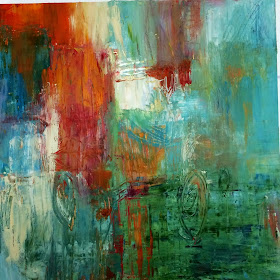For now I am very excited about the cold wax and oil process. After Lisa gave me a personal demo and shared her materials and knowledge with me I feel I have a much better understanding of how it works. Letting the work dry was the only challenge to me as I love to work fast. Working on many of them at one time helps. Below are some in process works that I did during the week that I can't wait to work on and finish. These are STARTS and need many more layers and fine tuning before they will be paintings! Most are on 12x12 cradled encaustic board from Ampersand and have a nice surface. They come in different size cradle depths.
The scratching and texturing was done with a sharp skewer and the layers are put on with
a print making brayer or squeegee. Revealing all the colors underneath is the most fun!
















